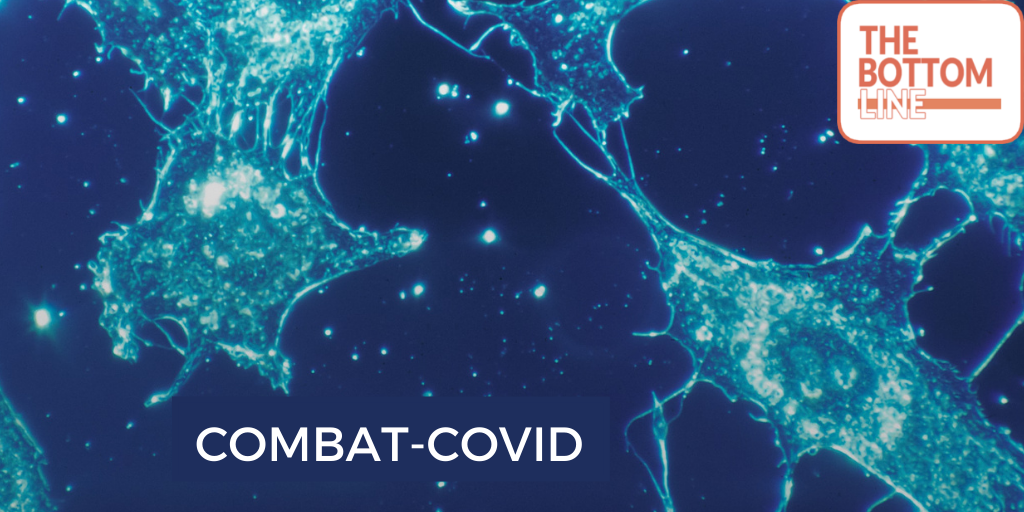COMBAT-COVID

Prostacyclin in Mechanically Ventilated Patients with COVID-19 and Severe
Endotheliopathy: A Multicenter, Randomized, Clinical Trial
Johansson, @AndersPerner 2021 Am J Respir Crit Care Med; Online ahead of print, Nov 23. doi: 10.1164/rccm.202108-1855OC
Clinical Question
- In mechanically ventilated patients with COVID-19 and severe endotheliopathy, does prostacylin compared with placebo, improve days alive without ventilation by day 28?
Background
- Endothelial dysfunction has been implicated as part of the core pathophysioloigy that leads to multi-organ failure and death in patients with severe COVID-19 infection
- Thrombomodulin is a transmembrane glycoprotein located on the surface of endothelial cells. It regulates coagulation and inflammation
- It is hypothesised that cleavage of thrombomodulin from the cell wall leads to a pro-thrombotic state
- Prostacyclin is released by endothelial cell with paracrine function. It causes vasodilatation and inhibits platelet aggregation and therefore may be of benefit for patients with severe COVID-19
Design
- Randomised controlled trial
- Permuted blocks of varying sizes
- Stratified by site
- Web-based concealed allocation
- Parallel-grouped exploratory trial
- Blinding of treating staff, investigators and statistician
- Multicentre
- Registered on clinicaltrials.gov
- Sample size calculation: 70 patients would provide 80% power to detect a 20% relative increase in the primary outcome from a baseline of 10 days with a false positive rate of 5%. Planned to recruit 80 patients to allow for ~10% drop-out
- Intention to treat analysis
Setting
- 5 university hospital ICUs in Denmark
- Data collected June 2020 – January 2021
Population
- Inclusion:
- Age ≥18
- Mechanically ventilated
- Confirmed SARS-CoV-2 infection
- Soluble thrombomodulin >4ng/ml
- Exclusion:
- Invasive mechanical ventilation > 72 hours
- Withdrawal from active therapy
- Pregnancy
- Life threatening bleeding
- Known severe heart failure (NYHA class IV)
- Suspected acute coronary syndrome
- 138 patients screened and 80 patients randomised
- Comparing baseline characteristics of intervention vs. control group
- Age: 68 vs 66
- Male: 73% vs 59%
- Caucasian: 93% vs 95%
- Admitted from
- Emergency Room: 22% vs 28%
- Ward: 68% vs 69%
- Chronic cardiovascular disease: 63% vs 59%
- Chronic respiratory disease: 15% vs 10%
- SOFA score at day of randomisation: 7 vs 7
- Vasopressor 24 hours before randomisation: 90% vs 87%
- RRT 24 hours before randomisation: 2% vs 5%
- Mechanical ventilation before screening: 12 vs 15 hours
- ICU admission before screening: 28 vs 21 hours
Intervention
- Prostacyclin (n=41)
- 1 ng/kg/min continuous intravenous infusion for 72-hours
- 5 patients discontinued the intervention
Control
- Placebo (n=39)
Outcome
- Primary outcome: Number of days alive without mechanical ventilation within 28 days – no significant difference
- Comparing intervention vs placebo group
- median 16 (SD 12) vs 5 days (SD 10)
- difference: 11 [95% CI -5 to 21]
- P= 0.07
- Comparing intervention vs placebo group
- Secondary outcomes:
- No significant difference in
- 28 day mortality
- 21.9% vs 43.6%
- risk ratio 0.50 [95% CI 0.24-0.96] P=0.06
- 90 day mortality
- 31.7% vs 48.7%
- risk ratio 0.65 [95% CI 0.36-1.12], P=0.17
- Median days alive and free of renal replacement therapy in the ICU within 28-days
- 28 days vs 21 days
- difference: 7 days [95% CI:(0-12)], P=0.06
- Median days alive and free of vasopressors in the ICU within 28 days
- 22 days vs 13 days
- difference: 9 [95% CI -18 to 1.5], P=0.14
- Serious adverse events and reactions within 7 days
- 2.4% vs. 12.8%
- risk ratio 0.19 [95% CI 0.001 – 1.11], P=0.10
- 28 day mortality
- No significant difference in
Authors’ Conclusions
- Prostacyclin was not associated with a significant improvement in the number of days alive and without mechanical ventilation within 28 days. However, the point estimate favoured prostacyclin and therefore further studies are needed
Strengths
- Randomised controlled trial
- Blinding of all staff including investigators and statistician
- Multi-centre
- Registered on clinicaltrials.gov
Weaknesses
- All patients were recruited from the capital of Denmark which may limit the external validity
- The number of patients that received steroids and IL-6 inhibitors in each group was not reported
- There were more men in the intervention arm than the control group (73% vs 59%). This baseline imbalance may cause chance bias, as men tend to have worse outcomes from severe COVID disease. An analysis adjusted for baseline imbalance would minimise this bias or alternatively, patients could have been stratified by sex at the time of randomisation. Although, in this particular study, this imbalance would likely strengthen the result
- The trial was likely underpowered, that is, insufficient individuals were enrolled to draw a meaningful conclusion but, it is certainly hypothesis generating and larger trials are indicated using the data from this study to guide sample size calculation
The Bottom Line
- In patients with COVID-19 and severe endotheliopathy, the use of prostacyclin was not associated with a significant improvement in the number of days alive and without mechanical ventilation. However, the study was underpowered, and the point estimate for all outcomes favoured the use of prostacyclin, with clinically significant differences reported
- Larger studies and therefore urgently needed to investigate the use of prostacylin for this population
External Links
Metadata
Summary author: @davidslessor
Summary date: 24th November 2021
Peer-review editor: @celiabradford
Image by: National Cancer Institute on Unsplash



